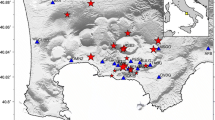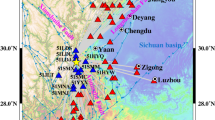Abstract
The aim of using simulation techniques to provide generated ground motion data is to extend our knowledge on the effect of earthquakes and understanding their physical properties. High-frequency accelerations have incoherent behavior because of unpredictable irregularities and heterogeneities associated with faulting and wave propagation. Simulations of ground motions frequencies beyond > 1 Hz can be represented with stochastic methods using simplified model representations of source, path and site effects. In this paper, stochastic simulations are performed for the recordings of the 26 September 2019 Silivri, Istanbul earthquake, using a finite fault simulation approach with a dynamic corner frequency. The main target is to create a valid synthetic model database with consistent source, path, and site parameters in the region that can be implemented in future simulation efforts. In calibration, we have used the recordings at 59 widely distributed stations in Istanbul located on different site conditions with epicentral distances ranging from 23 to 101 km. Four different frequency-dependent Q models were tested to obtain the best fit with the observations. By comparing generated ground motions to the observed ones, optimum source parameters and crustal characteristics were estimated. The calibrated model parameters have been obtained from the set of best-fit data with observed ground motion in frequency domain. Synthetic PGAs have been compared with the NGA-West2 Ground Motion Models (GMMs). Furthermore, spatial distributions of the ground motion intensity parameters were obtained and compared with available damage observations in Istanbul due to this earthquake. In conclusion, the results of the simulation were in good agreement with the recorded ones, both in time and frequency domains. The results indicate that the proposed stochastic model can be used to simulate ground motion distributions in Istanbul and beyond from past and future events in the region.





















Similar content being viewed by others
Data availability
The data generated during the current study are available from the corresponding author upon reasonable request.
References
Aki K (1980) Attenuation of shear-waves in the lithosphere for frequencies from 0.05 to 25 Hz. Phys Earth Planet Interiors 21(1):50–60
Akıncı A, Aochi H, Herrero A, Pischiutta M, Karanikas D (2017) Physics-based broadband ground-motion simulations for probable Mw ≥ 70 earthquakes in the Marmara Sea Region (Turkey) physics-based broadband ground-motion simulations for probable Mw ≥ 70 earthquakes. Bull Seismol Soc Am 107(3):1307–1323
Akıncı A, Malagnini L, Herrmann RB, Gok R, Sørensen MB (2006) Ground motion scaling in the Marmara region, Turkey. Geophys J Int 166(2):635–651
Akkar S, Sandıkkaya MA, Bommer JJ (2014) Empirical ground-motion models for point-and extended-source crustal earthquake scenarios in Europe and the Middle East. Bull Earthq Eng 12(1):359–387
Ambraseys N (2002) The seismic activity of the Marmara Sea region over the last 2000 years. Bull Seismol Soc Am 92(1):1–18
Anderson JG, Hough SE (1984) A model for the shape of the Fourier amplitude spectrum of acceleration at high frequencies. Bull Seismol Soc Am 74(5):1969–1993
Ansal A, Akıncı A, Cultrera G, Erdik M, Pessina V, Tönük G, Ameri G (2009) Loss estimation in Istanbul based on deterministic earthquake scenarios of the Marmara Sea region (Turkey). Soil Dyn Earthq Eng 29(4):699–709
Assatourians K, Atkinson G (2012). EXSIM12: a stochastic finite-fault computer program in FORTRAN, http://www.seismotoolbox.ca. Last accessed 10 Sept 2020.
Atkinson GM, Assatourians K (2015) Implementation and validation of EXSIM (a stochastic finite-fault ground-motion simulation algorithm) on the SCEC broadband platform. Seismol Res Lett 86(1):48–60
Atkinson GM, Boore DM (1995) Ground-motion relations for eastern North America. Bull Seismol Soc Am 85(1):17–30
Atkinson GM, Boore DM (2006) Earthquake ground-motion prediction equations for eastern North America. Bull Seismol Soc Am 96(6):2181–2205
Beyaz Gazete (2020) Depremde Ağır Hasar Gördü, Mührü Kırıp Oturmaya Devam Ettiler. (Retrieved December 8, 2020, from https://beyazgazete.com/haber/2020/1/29/depremde-agir-hasar-gordu-muhru-kirip-oturmaya-devam-ettiler-5421580.html).
Boore DM (1984) Use of seismoscope records to determine ML and peak velocities. Bull Seismol Soc Am 74(1):315–324
Boore DM (2003) Simulation of ground motion using the stochastic method. Pure Appl Geophys 160:635–676
Boore DM (2009) Comparing stochastic point-source and finite-source ground-motion simulations: SMSIM and EXSIM. Bull Seismol Soc Am 99:3202–3216
Boore DM, Joyner WB (1997) Site amplifications for generic rock sites. Bull Seismol Soc Am 87(2):327–341
Boore DM, Thompson EM (2014) Path durations for use in the stochastic-method simulation of ground motions. Bull Seismol Soc Am 104(5):2541–2552
Büyükçekmece Municipality (2020) 17/11/2020 Press Release. (Retrieved December 8, 2020, from https://www.bcekmece.bel.tr/haberdetay?id=186)
Chiou BSJ, Youngs RR (2014) Update of the Chiou and Youngs NGA model for the average horizontal component of peak ground motion and response spectra. Earthq Spectra 30(3):1117–1153
CNN Türk (2019). Son dakika... İstanbul Silivri'de deprem: Cami minaresi çöktü, yan yatan bina boşaltıldı. Retrieved December 8, 2020, from https://www.cnnturk.com/video/turkiye/son-dakika-istanbul-silivride-deprem-avcilarda-hasara-neden-oldu-cami-minaresi-coktu
CNN Türk (2019b) Son dakika: İstanbul'da büyük deprem!. Retrieved December 8, 2020, from https://www.cnnturk.com/video/turkiye/son-dakika-istanbulda-buyuk-deprem
DASK (2019) Natural Disaster Insurance Institution Annual Activity Report 2019. Retrieved December 8, 2020, from https://dask.gov.tr/content/pdf/2019_dask_faaliyet_raporu.pdf
DASK (2019b) Natural Disaster Insurance Institution, 10/09/2019 Press Release. Retrieved December 8, 2020, from https://dask.gov.tr/content/pdf/0930IstanbulDepremBb_rev03.pdf
Durukal E (2002) Critical evaluation of strong motion in Kocaeli and Düzce (Turkey) earthquakes. Soil Dyn Earthq Eng 22(7):589–609
Durukal E, Catalyurekli Y (2004) Spectral analysis of source parameters of the 1999 Kocaeli and Düzce earthquake aftershock sequences. In: 13th World Conference on Earthquake Engineering, Vancouver BC, Canada, Paper (vol 421)
ELER v3.1 (2010) Earthquake loss estimation routine. In: Technical manual and users guide. Boğaziçi University, Department of Earthquake Engineering, http://www.koeri.boun.edu.tr/depremmuh/ELER/ELER_v3_Manual.pdf. Accessed 8 Dec 2020
Emre Ö, Duman TY, Özalp S, Elmacı H, Olgun Ş, ve Şaroğlu F (2013) Açıklamalı Türkiye Diri Fay Haritası. Ölçek 1:1.250.000, Maden Tetkik ve Arama Genel Müdürlüğü, Özel Yayın Serisi-30, Ankara-Türkiye. ISBN: 978-605-5310-56-1
Evrensel (2019) İstanbul'da 5.8 büyüklüğünde deprem: Toplam 77 binada ağır hasar tespit edildi. Retrieved December 8, 2020, from https://www.evrensel.net/haber/387647/istanbulda-5-8-buyuklugunde-deprem-toplam-77-binada-agir-hasar-tespit-edildi
Evrensel (2019b) Silivri’de hasar gören okul mühürlendi; Avcılar’da 258 bina incelenecek. Retrieved December 8, 2020, from https://www.evrensel.net/haber/387722/silivride-hasar-goren-okul-muhurlendi-avcilarda-258-bina-incelenecek
Governorship of Istanbul (2019) Republic of Turkey Governorship of Istanbul, 29/09/2019 Press Release. Retrieved December 8, 2020, from http://istanbul.gov.tr/deprem-ile-ilgili-on-hasar-calismalarinda-son-durum
Haberler (2020) Silivri Depreminde Hasar Gören Cami Yıktırıldı. Retrieved December 8, 2020, from https://www.haberler.com/silivri-depremi-nde-hasar-goren-cami-yiktirildi-13566814-haberi/
Herrmann RB (1985) An extension of random vibration theory estimates of strong ground motion to large distances. Bull Seismol Soc Am 75(5):1447–1453
Horasan G, Kaşlılar ÖA, Boztepe GA, Türkelli N (1998) S wave attenuation in the Marmara region, northwestern Turkey. Geophys Res Lett 25:2733–2736
IBB (2019) İBB Baskani Ekrem İmamoglu’nun Deprem Seferberlik Sunum Dosyasi. Retrieved December 8, 2020, from https://depremzemin.ibb.istanbul/deprem-seferberlik-plani/
IBB-OYO-KOERI (2009) İstanbul’un Olası Deprem Kayıpları Tahminlerinin Güncellenmesi İşi, Proje Çalışma Raporu, Boğaziçi Üniversitesi, Deprem Mühendisliği Bölümü, Istanbul
Karabulut H, Güvercin SE, Eskiköy F, Konca AÖ, Ergintav S (2020) The moderate size 2019 September Mw 5.8 Silivri earthquake unveils the complexity of the Main Marmara Fault shear zone. Geophys J Int 224(1):377–388
KOERI (2019) 26 Sept. 2019 (13:59) Istanbul-Off Silivri Earthquake, September 26, 2019. Report on Istanbul Earthquake Rapid Response System's preliminary estimations. Retrieved December 8, 2020, from https://eqe.boun.edu.tr/sites/eqe.boun.edu.tr/files/26-09-2019-silivri_depremi_eng.pdf
Malcıoğlu FS, Suleyman H, Çaktı E (2022) Seismological and engineering characteristics of strong motion data from 24 and 26 September 2019 Marmara Sea Earthquakes. Bull Earthq Eng 20:5567–5599. https://doi.org/10.1007/s10518-022-01422-y
Motazedian D, Atkinson G (2005) Stochastic finite fault modeling based on a dynamic corner frequency. Bull Seism Soc Am 95:995–1010
MTA (2004) 1/500,000 scale geological maps of Turkey, https://www.mta.gov.tr/v3.0/hizmetler/500cd
Pischiutta M, Akıncı A, Tinti E, Herrero A (2021) Broad-band ground-motion simulation of 2016 Amatrice earthquake, Central Italy. Geophys J Int 224(3):1753–1779
Pulido N, Ojeda A, Atakan K, Kubo T (2004) Strong ground motion estimation in the Sea of Marmara region (Turkey) based on a scenario earthquake. Tectonophysics 391(1–4):357–374
Silivri Municipality (2020) 09/03/2020 Press Release. Retrieved December 8, 2020, from https://www.silivri.bel.tr/haber/news_1583753743_png/4697.
Sørensen MB, Pulido N, Atakan K (2007) Sensitivity of ground-motion simulations to earthquake source parameters: a case study for Istanbul, Turkey. Bull Seismol Soc Am 97(3):881–900
Suleyman H (2018) Estimation of the high-frequency decay parameter (κ) and anelastic attenuation factor (Q) for Istanbul. M.Sc. Thesis. Boğaziçi University, Dept. of Earthquake Engineering, Istanbul, Turkey
Uğurhan B, Askan A (2010) Stochastic strong ground motion simulation of the 12 November 1999 Düzce (Turkey) earthquake using a dynamic corner frequency approach. Bull Seismol Soc Am 100(4):1498–1512
Zengin E, Çaktı E (2012) Scenario based ground motion simulations for Istanbul, Turkey. In: Proceedings of 15th World Conference on. Earthquake Engineering, 24–28 September 2012. Lisbon, Portugal, pp 24557–24566
Acknowledgements
The study is based on the data from the Istanbul Earthquake Rapid Response and Early Warning System operated by the Department of Earthquake Engineering of Boğaziçi University’s Kandilli Observatory and Earthquake Research Institute. We thank two anonymous reviewers for their careful reading and helpful feedback.
Funding
This work has been partially supported by UKRI-GCRF in the framework of the project “Tomorrow’s Cities”.
Author information
Authors and Affiliations
Corresponding author
Ethics declarations
Conflict of interest
The authors declare that they have no conflict of interest.
Additional information
Publisher's Note
Springer Nature remains neutral with regard to jurisdictional claims in published maps and institutional affiliations.
Supplementary Information
Below is the link to the electronic supplementary material.
Rights and permissions
Springer Nature or its licensor (e.g. a society or other partner) holds exclusive rights to this article under a publishing agreement with the author(s) or other rightsholder(s); author self-archiving of the accepted manuscript version of this article is solely governed by the terms of such publishing agreement and applicable law.
About this article
Cite this article
Yenihayat, N., Çaktı, E. & Şeşetyan, K. Stochastic ground motion simulation of the 26 September 2019 Mw 5.8 Silivri (Istanbul) earthquake. Bull Earthquake Eng 22, 1605–1633 (2024). https://doi.org/10.1007/s10518-023-01806-8
Received:
Accepted:
Published:
Issue Date:
DOI: https://doi.org/10.1007/s10518-023-01806-8




